-
Posts
83 -
Joined
-
Last visited
-
Days Won
6
Bruce Pennington last won the day on January 24
Bruce Pennington had the most liked content!
About Bruce Pennington
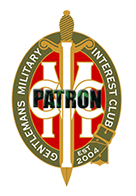
Contact Methods
-
Website URL
https://essaysonreality.substack.com/
Profile Information
-
Location
Colorado
-
Interests
Japanese war swords, Biblical studies
Recent Profile Visitors
689 profile views
Bruce Pennington's Achievements
-
Hi Col.! Thanks for sharing your collection. I just collect swords, but going to enjoy seeing your full collection. For some strange reason, swords don't bother me, but the idea of a bayonet give me the heeby-geebies! It runs my imagination too vividly. On sizing. I haven't had to use them, but there are several free online sites you can resize your photos. Guys over at NMB recommend them, so they must work. Try one of these: Free Online Photo Resizers
-

My Type 95 NCO Collection
Bruce Pennington replied to Bruce Pennington's topic in Swords & Edged Weapons
My final Type 95 is of the wooden handle style. I don't have the exact date, but somewhere in the last couple years of the war, they stopped using aluminum, probably due to war shortages, and went to wood for the tsuka. They were almost all produced in the Seki area with some made in 1945 by the Heijō Factory located in Pyongyang, Korea. All were processed by the Nagaoya Army Arsenal. There were 4 patterns as production standards were lowered over time. You can see them in this chart made by "Stegel" at NMB: Another production change in the last year of the war involved skipping the bohi, or fuller groove. It is assumed this was simply to speed up production, as the army was actually increasing quotas on the arsenals. Note the production numbers in this chart, for '44 and '45: So, my late war 95 is of pattern 5, serial # 211894. It came painted gold & black. Believing it to be a post-war Bubba paint job, I stripped it and found the original factory paint still there. After a few years of discovery and discussion, were have found many gold & black painted swords and now consider it possible that it was something done in the field by the troops themselves. Before: After: Serial number with Seki inspection mark. Note the lack of bohi. -
Bruce Pennington started following Swords & Edged Weapons
-

My Type 95 NCO Collection
Bruce Pennington replied to Bruce Pennington's topic in Swords & Edged Weapons
At some point in time, Nagoya made a few gunto with a side latch. This is before the late-war, wooden handled versions. They only made 4,000 of them, which makes them more rare than the copper handles! Some are "Na" stamped, in the 130000 number range, and some are "Seki" stamped in the "200000" range. I have one of each. 134112 came with a mottled green paint. I, unfortunately, thought it to be a bad post-war Bubba job and stripped it off. Since then, a couple more have popped up on the forums with the exact same paint scheme. I think they were wartime legit. Mine was very difficult to strip, a sign I learned later that indicates WWII paint, not modern. 202446 I have observed that the Quality Control run by the Nagoya arsenal was a bit looser than that of the Tokyo 1st Arsenal. Note the starting point of the bohi on both sides. You won't see that sort of sloppiness on a Tokyo 1st Type 95. Of the two makes, the Seki Token often has stamps on the steel fuchi, though they are poorly struck and hard to see. Number 9 on this chart - Seki Token .. NA .. Nagoya Army Arsenal -

My Type 95 NCO Collection
Bruce Pennington replied to Bruce Pennington's topic in Swords & Edged Weapons
Around 1938, the Army revised the Type 95s using aluminum for tsuka and a lighter steel for the saya, and a drag was added. I found one for a good price because someone over the years had painted it gold - even the blade! Made between 1939 and 1942, by Iijima Token Seisakusho for the Tokyo 1st Amry Arsenal, final acceptance by the Kokura Army Arsenal. Serial number 92605. I discussed it at length with guys on a few websites and all agreed it was a post-war re-paint. One guy had parents that worked in a theatre group and he said there was always a pile of swords in the corner backstage, all painted gold. If you're doing The King and I, are you going to use a sword painted Army khaki green? No, of course not! So, they'd paint all their swords gold. I decided to strip it with acetone. After 1972, leaded paint was outlawed and the new paint comes off with acetone fairly easy. If the paint were WWII vintage, it resists coming off and requires a lot more work. I went after it, and sure enough, it came off pretty easy. Next, I talked to a friend that did really good model airplane paint work. He agree to do the tsuka and told me how to do the saya. The colors aren't an exact match to the real thing, and it looks too good, but it's a heck of a lot better than it was. It's the 3rd one from the left in the first photo at the very top of the thread. -
Tracy, Rookie question - Do you think the reason for the star on the anchor is that the organization was recruiting for both Army & Navy?
-

My Type 95 NCO Collection
Bruce Pennington replied to Bruce Pennington's topic in Swords & Edged Weapons
I got my copper handled 95 several years ago and paid almost twice the price of a standard 95, from a dealer, but I'm glad to have it. The money is long gone, but the sword is still mine! They only made the coppers for about 10 months, and just over 7,000 of them. Mine is 2643, so just inside the first half. All of them were made by Suya Shoten Mine has a replacement saya throat, un-numbered. I have seen a few of these over the years and believe they were a factory repair. In hand, they are quite heavy. I can see why they changed to an aluminum tsuka and lighter steel saya in the next version. I always take mine apart for inspection and cleaning, however some guys recommend against it as they sometimes get some looseness in the fit once reassembled. Other than an arsenal stamp and one of the "W"s, there is nothing to be seen by removing the tsuka on a 95. -
Bruce Pennington started following My Contingency Model of the Type 98 Officer Sword and My Type 95 NCO Collection
-
If you haven't already read them, I highly recommend reading through Ohmura's Type 95 pages - Non-commissioned Officers Type 95 Gunto Nick Komiya's - Evolution of the Type 95 Stu W's - IJA Type 95 Sword Info and the NMB thread - Fake Type 95 NCO Swords I tried to collect a fair representation of the various versions of the 95. I now have 8. I know a couple of guys that did that and wound up with 50 and 80! Ha! I'll start with some overall pics. As I began preparing for this post, I realized that many of my photos were taken back when I hardly knew anything about WWII swords, and certainly knew very little about how to take pictures of them. Consequently, I'm going to take some time to get some good shots of them all and post as I go. To begin, here are the 8, 4 Korkura/Tokyo 1st and 4 Nagoya More to follow as I get good close-us!
-
Takayama Masayoshi was a Gunzoku Naval officer teaching sword technique at the Naval Academy. He had studied WWI trench warfare and realized that time was crucial in hand-to-hand combat. He decided to design his own sword, a bit shorter and heavier with more mass at the tip, with the idea of "one strike, one kill" thus minimizing the time spent with an opponent. His design can be found in both Army and Navy gunto. Some are signed as Takayamato, some, like mine, are mumei. After the war, Takayama fled to the countryside. He was found guilty of war crimes in absentia and sentenced to 7 years, for experimenting with his One Strike technique on a few dozen Chinese POWs during the war. He returned after amnesty was declared and lived out his life as an instructor. Takayama My kaigunto. Likely late war with the single haikan You can see the blade is shorter than normal, and has that fat tip
- 1 reply
-
3
-
Really cool, thanks for posting. The topic has come up a couple times, recently, so I'll post this here, though it probably should go in the Books discussion thread. "The Divine Wind", by Captain Rikihei Inoguchi and Commander Tadashi Nakajima, Bantam War Book, 1958. Inoguchi and Nakajima were instrumental in making the Special Attach Units happen. A couple of fascinating statements at the beginning of the book: "On the eve of war there was a fear in Japan that revolution was imminent. Admiral Yamamoto maintained that while civil war would not be fatal to the nation, an external war that had no chance of success would spell disaster. Accordingly, he was vigorously opposed to the idea of going to war. At the same time he said that as a result of the domestic situation, the evolution toward war was inevitable. .... " Vice Admiral Shigeru Fukudome "...in an Imperial conference on September 6, 1941...a way was left open on the chance that satisfactory diplomatic arrangements could be achieved without recourse to military means. Even if we could not win a military victory, it was incumbent upon us to resort to arms in order to remain loyal to the Japanese spirit, which had to be preserved at all costs. After the agenda had been approved, Admiral Nagano, representing the high command, commented on this point: "It is agreed that if we do not fight now, our nation will perish. But it may well perish even if we do fight. It must be understood that national ruin without resistance would be ignominy." They did a good job telling the story of how they found themselves clearly losing, yet so passionate about their cause that they would resort to this last ditch effort. People often recoil at the Kamikaze, or Special Attack Force, concept and find it hard to comprehend, but it's not really that hard once you learn more about the people involved and the predicament they found themselves in. And honestly, it's not that hard to understand for a warrior. My wife, to this day, doesn't understand those of us who feel called to join the armed forces (even police force), because to her, there is nothing more important than self preservation. Yet even for her, if her child (or favorite dog) is in danger, she would throw caution to the wind and rush protect them, not even thinking of her own safety. The authors discuss this a bit, and mention how most people and/or soldiers are willing to risk their lives, but deep down believe they have a chance to survive. The Kamikaze shocks the senses because the observer knows that person is making this effort knowing there is no way out. But to the pilots of the time, they realized that for Japan, there was no way out. The massive, overwhelming forces of the US in the Pacific made that clear. It was amazing to read how, when briefed on the idea at first, 100% of the pilots volunteered, and those who were turned away, for whatever reason, were truly hurt. But even this was really the strongest in the front line forces. The military back home, in their relative safety, weren't as easily convinced. It was seen, too, in the new pilot trainees, after all the veterans were lost. The new guys had more skittishness, until they spent some time out on the front. This reminds me of the book written by Japan's top ace, Saburo Sakai, "Samurai!". He was unwilling to fly a Kamikaze mission. Possibly this is because of his skill and success. In his mind, there is always the chance of surviving to fight another day.
-
I have never heard a definitive answer to the use of English letters, but one I heard that might have something to it was it came during the era when Japan was modernizing. Many people from around the world were brought in for both military and business. The influence stuck, apparently.
-
Of all the WWII Japanese swords, I think the kaigunto is the most attractive. Mine has a 1943 blade made by Yoshishige, with large Seki stamp. The model was officially released in 1937, so it's called a Type 97. You can read about its development on Nick Komiya's post 1937 Launch of the New Navy Gunto. Also, Ohmura has exquisite photos of them: Navy Tachi Gunto. "Gunto" means Army (Gun) Sword (To). So kaigunto is literally "Navy (Kai) Army Sword" Ha! But the term "gunto" took on it's own life as a generic term for military sword by the time the Navy designed their own. Except for the very late war version, they kept the 2 haikan (belt ring) design throughout the war, whereas the army dropped the second ring in 1938. Metal parts were gold gilded. Rayskin was lacquered black and the ito (handle wrap) was normally not folded. The brown navy tassel was used by all ranks.
-
The previous yellow "Koa" medal is interesting, as it fits a cultural slogan in use during the era of "Uniting the 7 Tribes of Asia" or "Asia is One Heart". It is seen on SMR Mantetsu blades, and according to the late Nick Komiya at Warrelics, was used widely throughout Japan in various venues.
-
Do you know the significance of the lion, shovel, and pick? Was the unit an engineer group?
-
Commonly called the "Type 3", or "Type 44", or "Marine Landing Sword", along with many other names that are farther off base, the Army wanted a simplified, cheaper, yet sturdier version of the officer sword. They used a loophole in the Type 98 Emperor Order to create a temporary, contingency model. Designed in 1938, produced and marketed in 1940, the Rinji seishiki (Contengency model in Japanese) or "RS" for short, didn't really catch on until after 1942, and most we see today hold blades made in 1944/45. You can read about the history of the version on Nick Komiya's pages: Deflating the Myth of the "Type 3" nomenclature and Unveiling the Rinjiseishiki Sword in 1940 My RS comes with a 1945 gendaito made by the RJT smith Kunitoshi. The blade has several corrosion spots, so not a pretty sight, but if I ever decide to have it polished it will be quite beautiful. The standard RS model came in a light tan colored saya with 1 chuso (release button). The blades in them are showato. Once the style became popular, officers ordered upgraded fittings to include lacquered wood, and eel, ray, or sharkskin covers. The rigs with RJT blades are almost always in such upgraded fittings, and you will see double release chuso buttons. Mine has the double buttons, but has a tan, metal saya, though you can see that it had a slightly upgraded texture to the paint. The blade Kunitoshi with Star stamp
-
5


(1).thumb.jpg.38cff8cd9c5d55311a4208b0a83448ba.jpg)

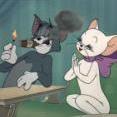



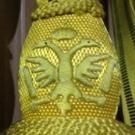
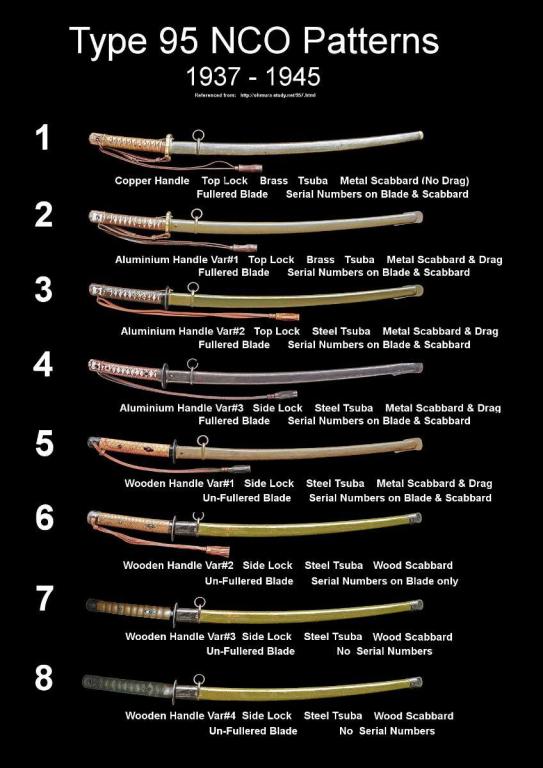

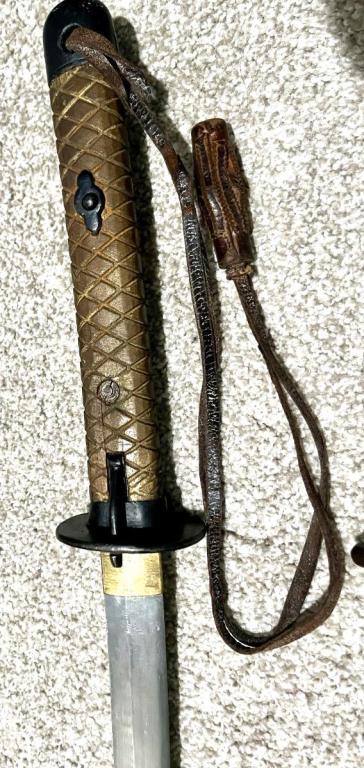
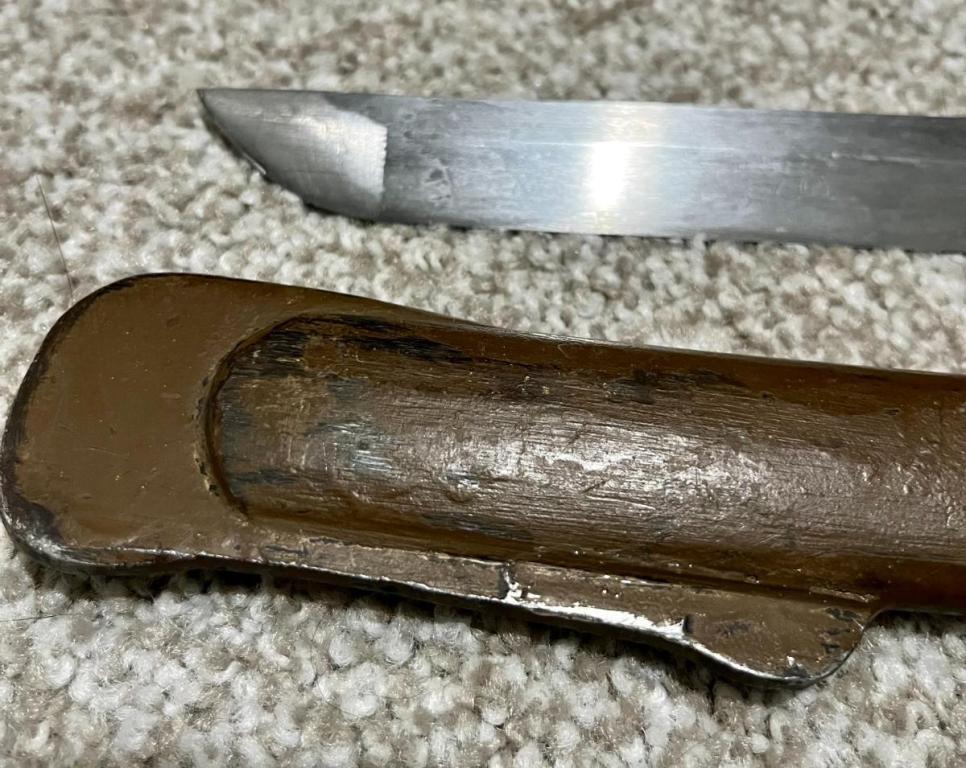
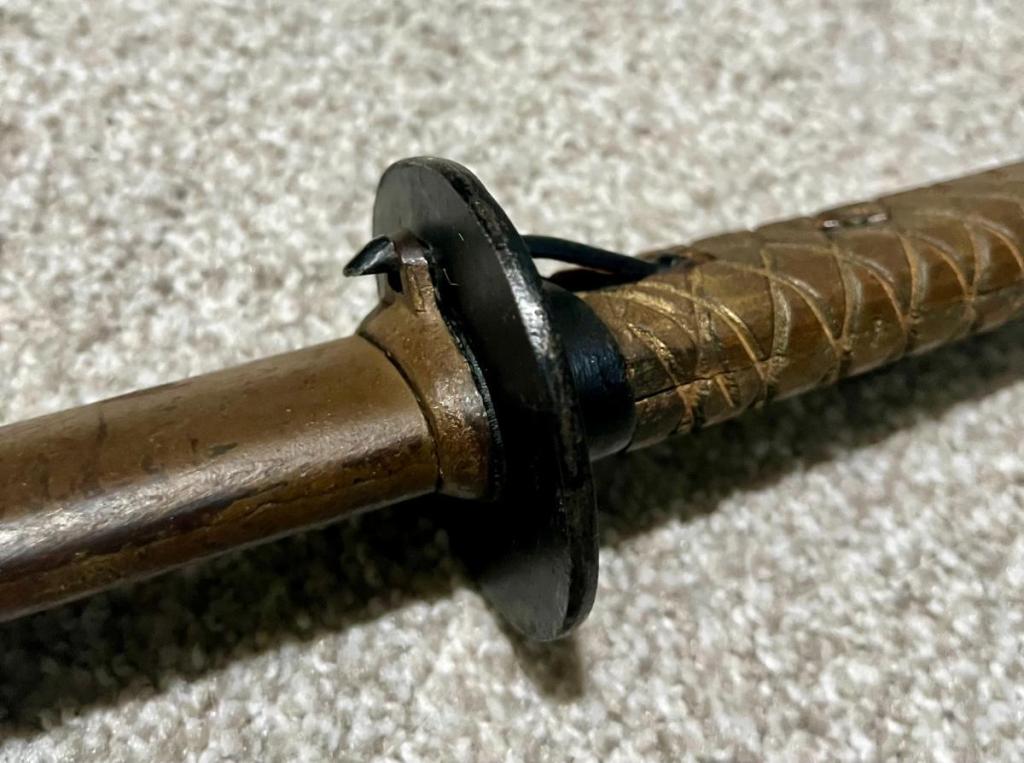



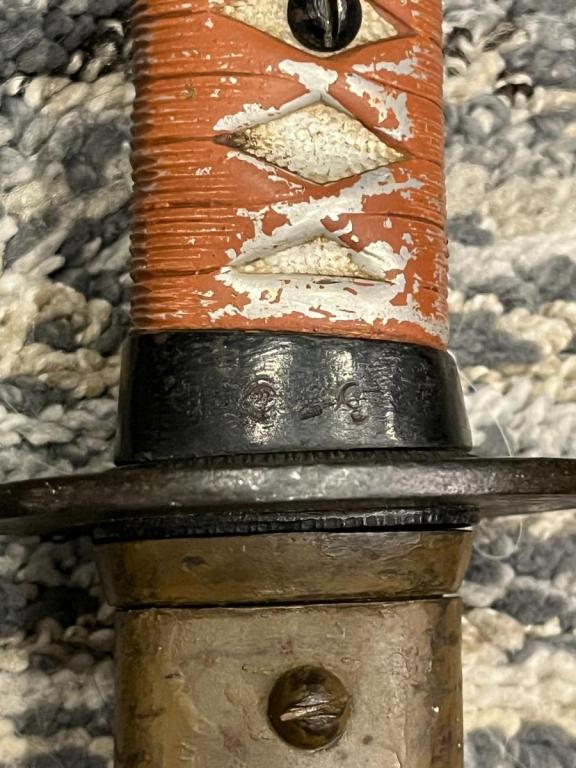
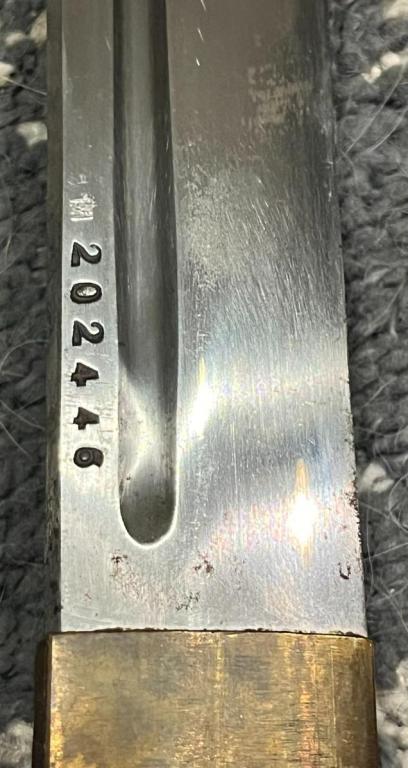
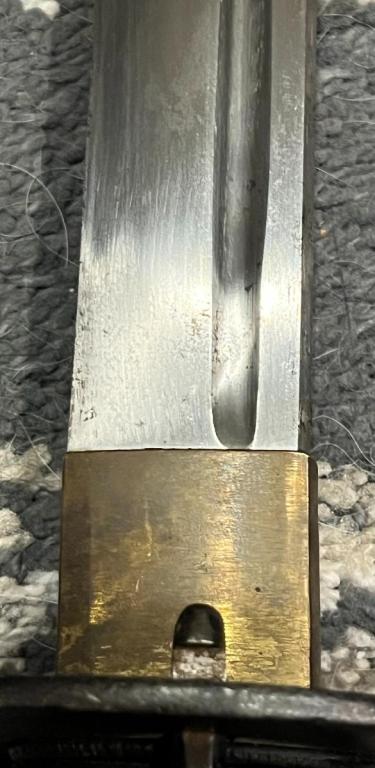
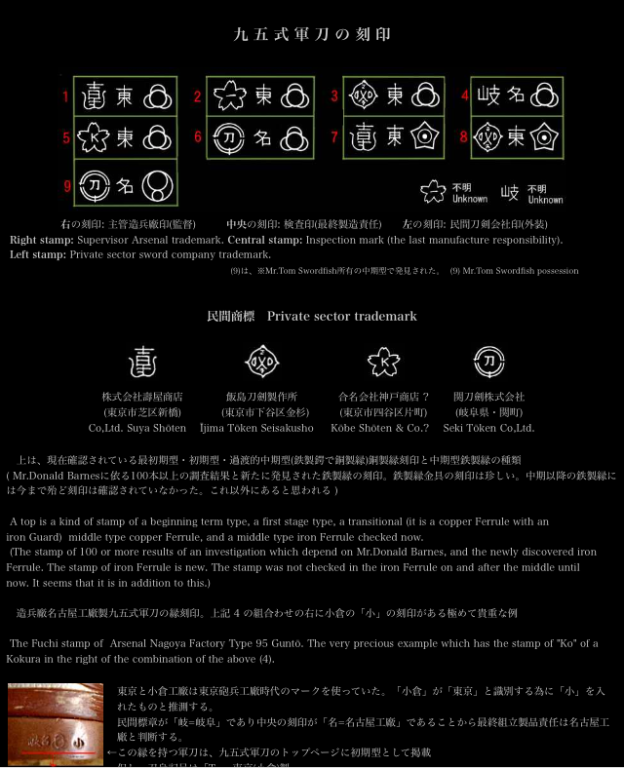
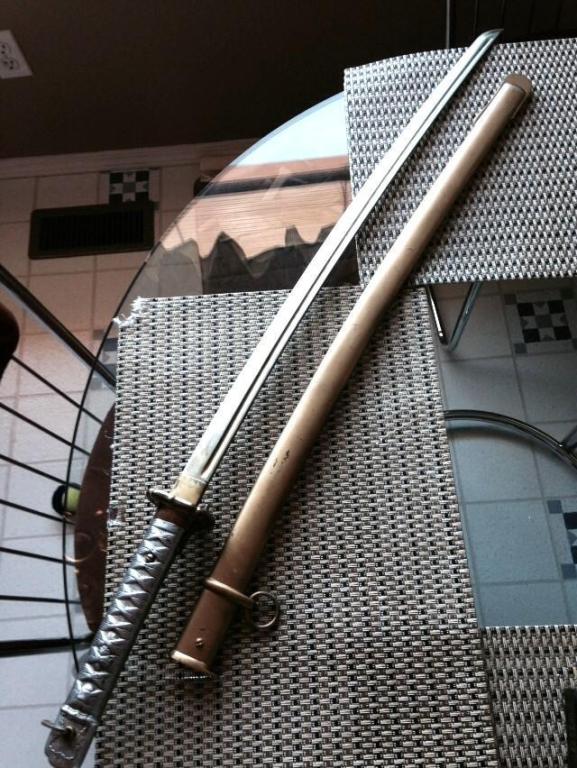

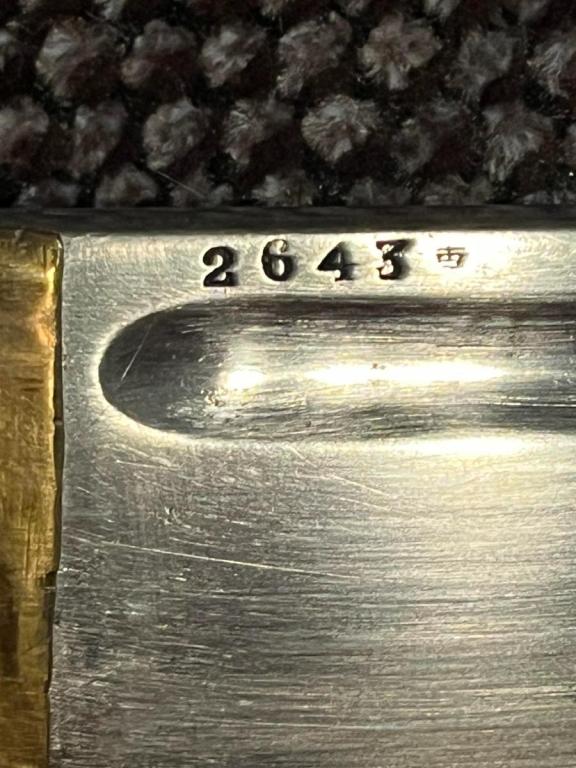
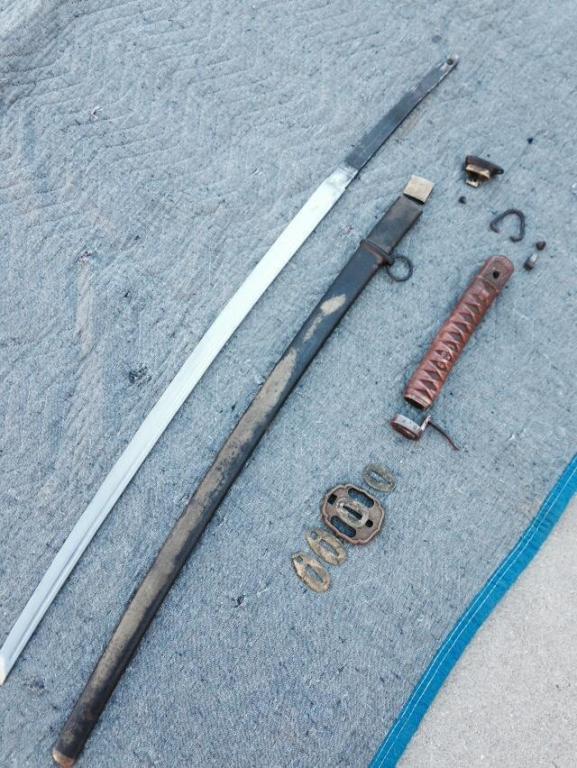
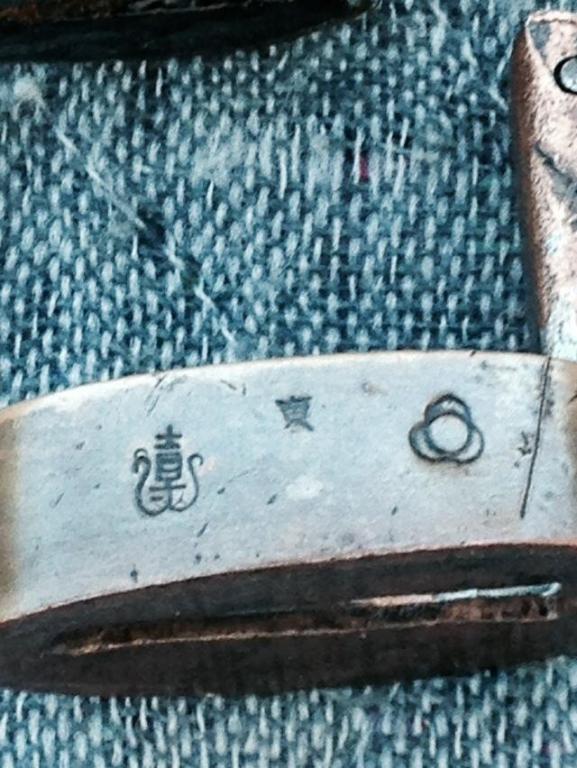
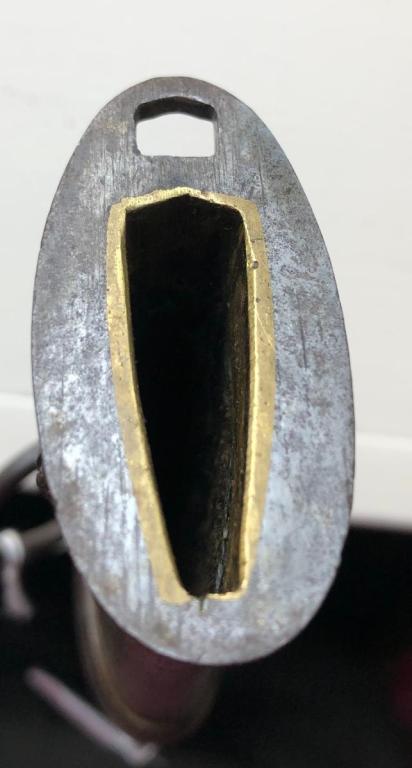

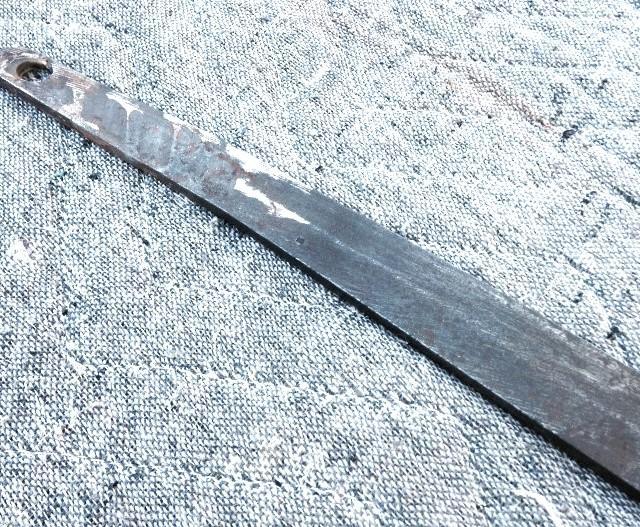
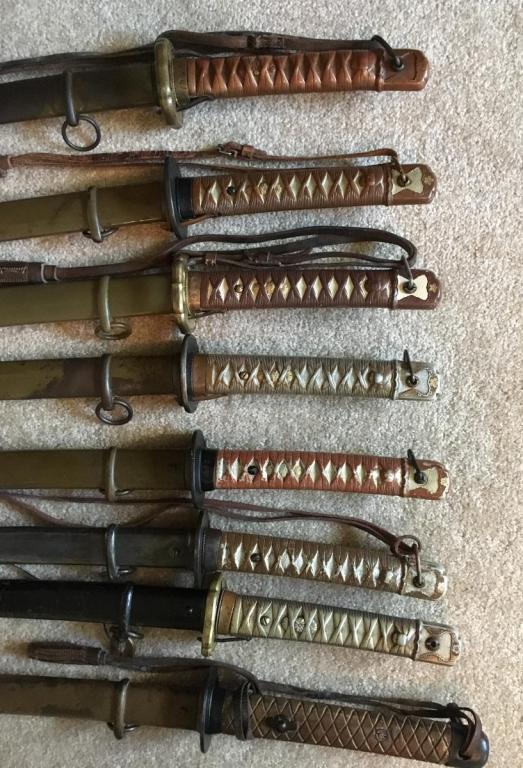
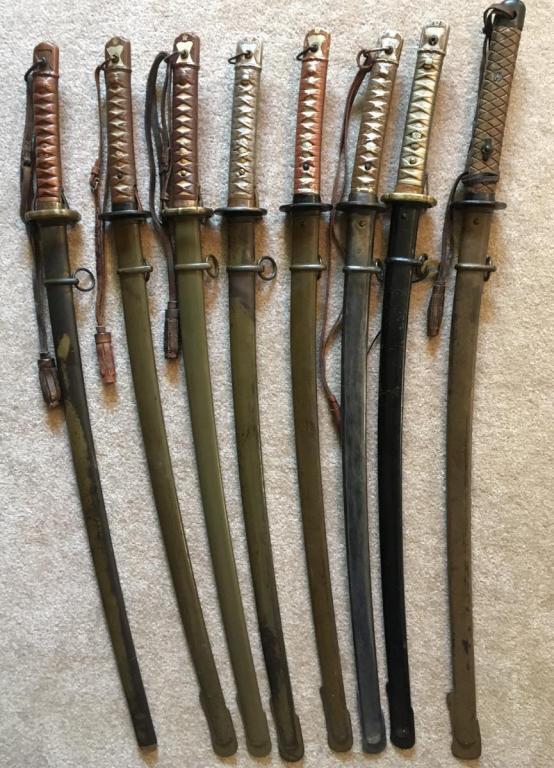
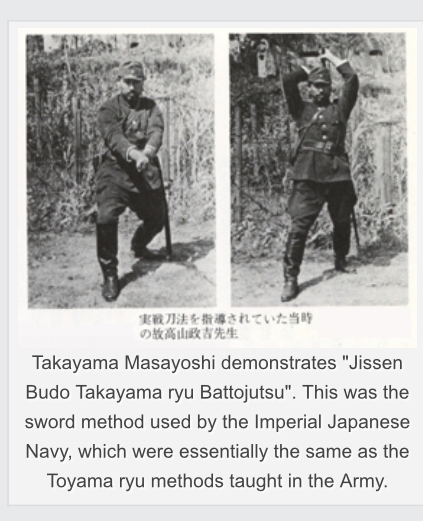

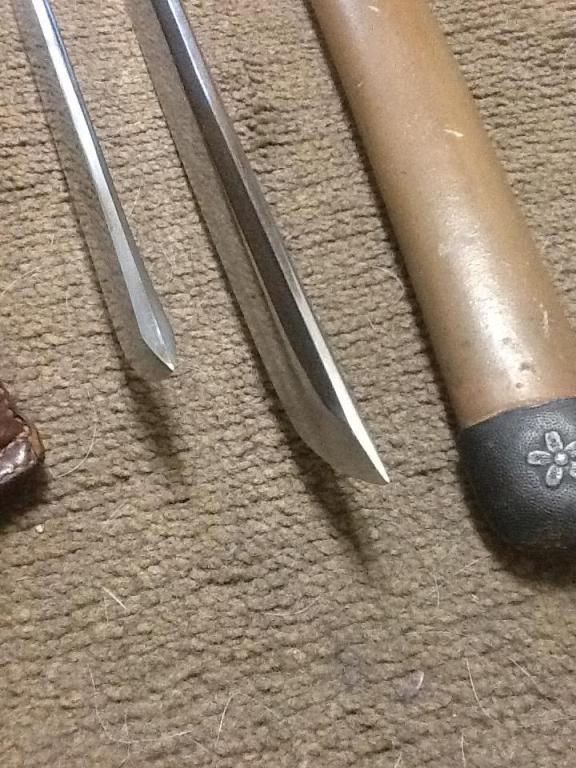

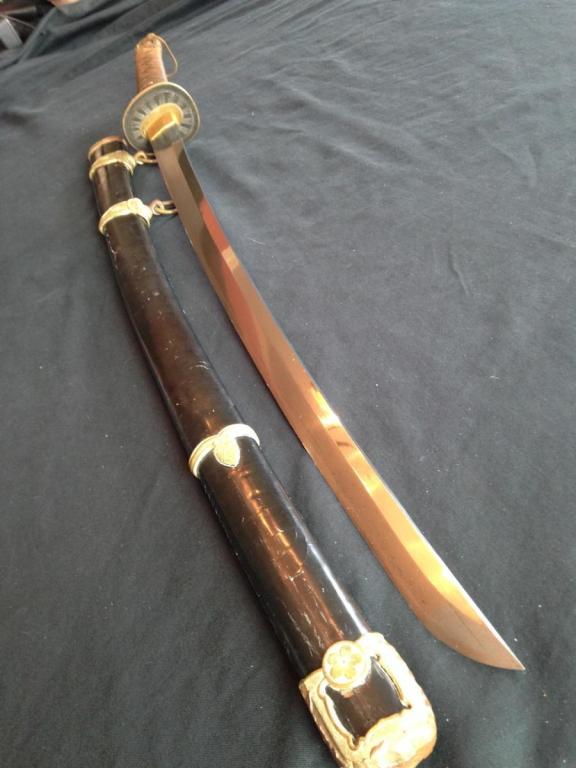
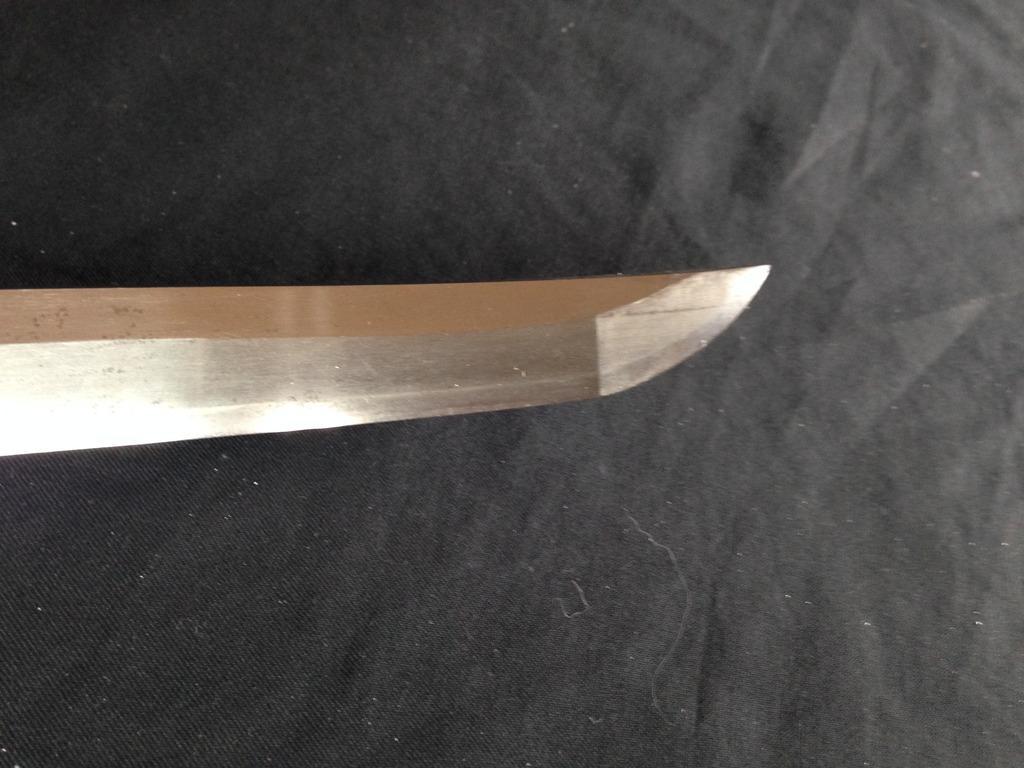
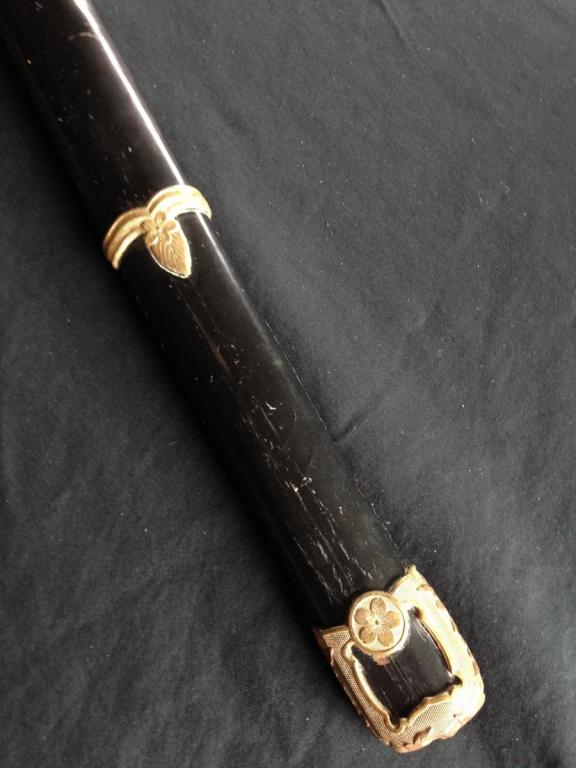

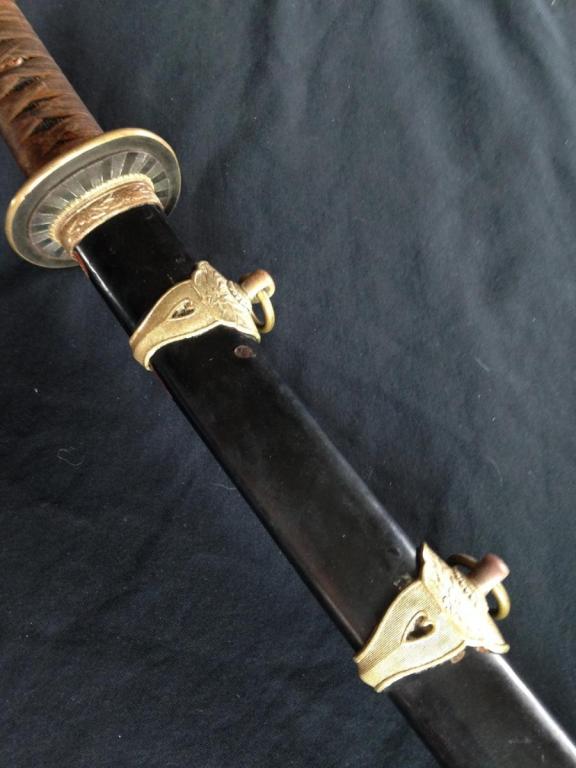



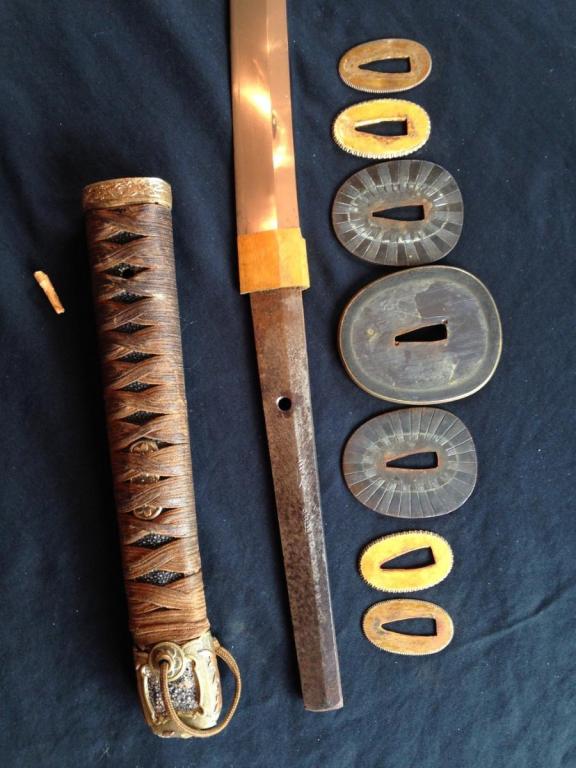
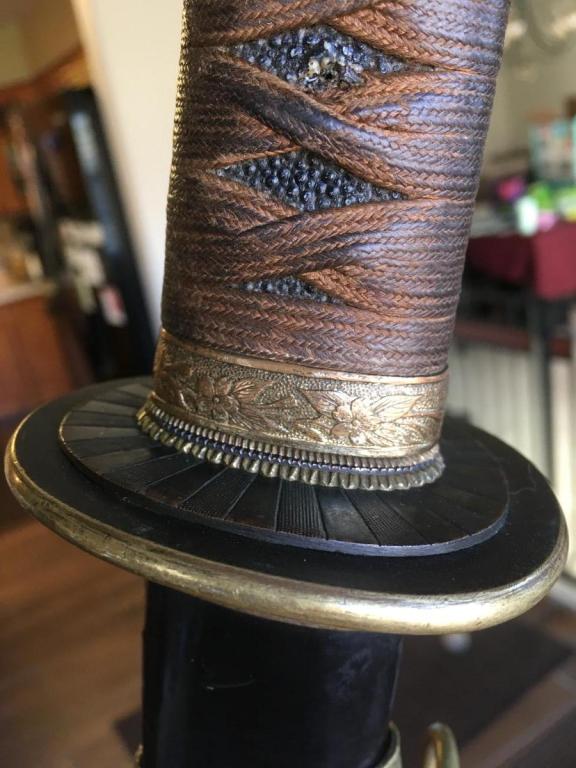
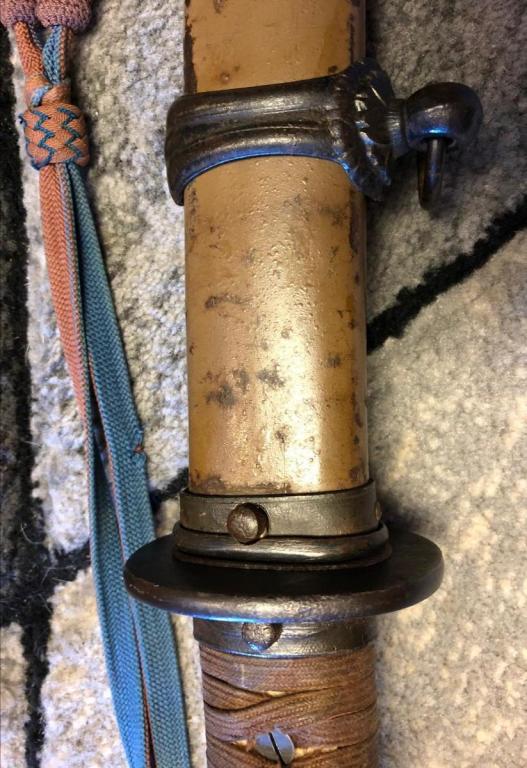
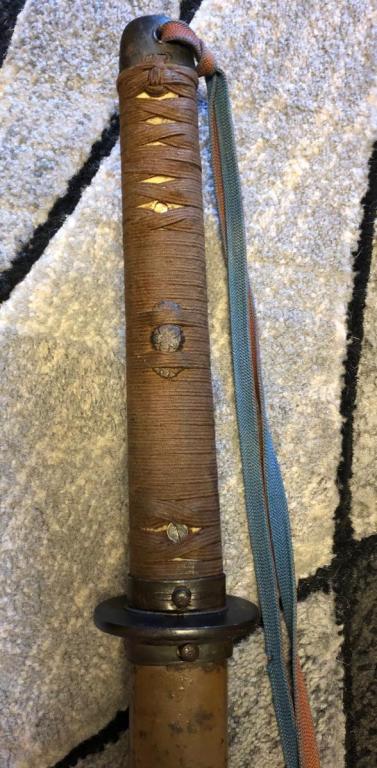

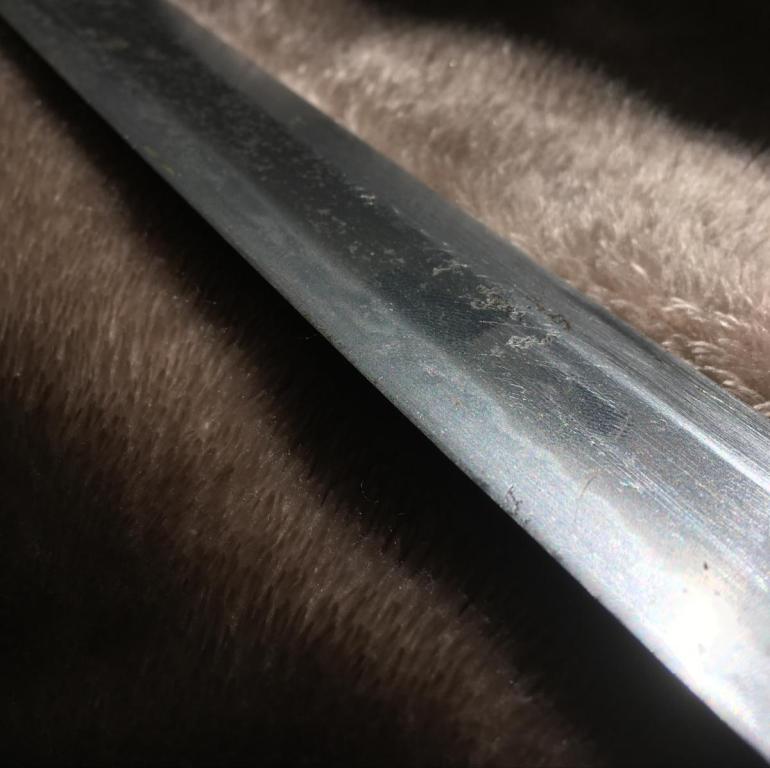
.jpg.37a9a024556d1e1ea793d7e7ad0f092e.jpg)